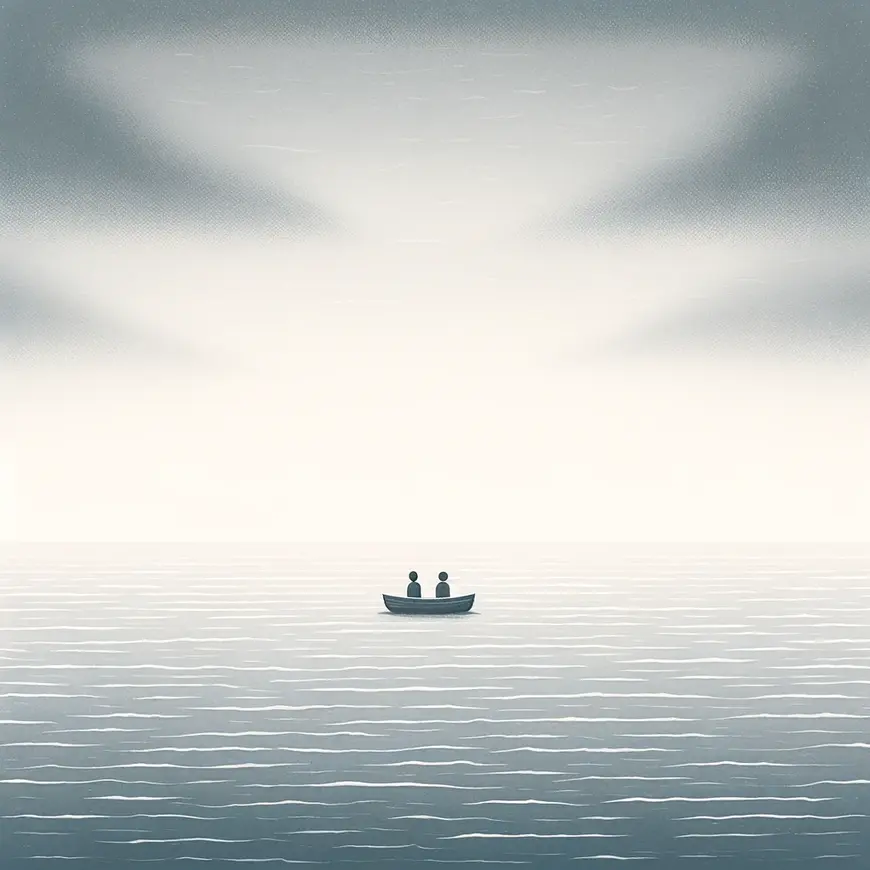“I am the Wind” by Jon Fosse: A Haunting Meditation on Existence and Identity
Jon Fosse’s “I am the Wind” is not just a play—it’s a haunting and atmospheric journey into the depths of the human soul. Originally published in 1997, this minimalist masterpiece invites readers to contemplate the essence of existence. As we immerse ourselves in “I am the Wind,” we are swept away on a odyssey that lingers long after the final curtain falls.
Unveiling the Poetic Depths of “I am the Wind”
The Power of Minimalism: One of the most striking aspects of “I am the Wind” is its minimalist approach to storytelling. Fosse’s spare and poetic language creates an atmosphere of haunting beauty, inviting readers to fill in the gaps with their own interpretations and emotions. With each carefully chosen word and image, Fosse weaves a tapestry of existential longing and poetic resonance that resonates deeply with the reader.
The Journey of the Protagonists: At the heart of “I am the Wind” are the two nameless protagonists—simply referred to as “The One” and “The Other.” As they embark on a surreal and dreamlike journey across the sea, their identities and motivations remain shrouded in ambiguity. Are they lovers? Friends? Strangers bound together by fate? Fosse leaves these questions unanswered, allowing readers to project their own desires and fears onto the enigmatic characters.
The Sea as a Metaphor: Throughout “I am the Wind,” the sea serves as a powerful metaphor for the passage of time and the inexorable march of life. As The One and The Other drift aimlessly across the water, they confront their own mortality and the fleeting nature of existence. The sea becomes a symbol of both liberation and confinement, inviting readers to ponder the eternal rhythms of life and death that govern the human experience.

The Depths of Existential Angst
Existential Longing and Despair: At its core, “I am the Wind” meditates on existential longing and despair. It explores the emptiness and alienation in the human condition. As The One and The Other drift further from shore, they face the futility of their existence and the fleeting nature of human connection. Fosse’s spare and evocative language captures the deep sense of isolation and longing. This invites readers to confront their own mortality and search for meaning in an indifferent universe.
The Illusion of Control: Despite their efforts to steer their boat, The One and The Other realize the futility of their actions. Like Sisyphus pushing his boulder, they are trapped in a cycle of repetition and futility. They cannot escape the forces of fate and mortality. Fosse’s exploration of the illusion of control speaks to the human desire to assert agency over our lives, even against overwhelming odds.
The Quest for Identity: Throughout “I am the Wind,” The One and The Other grapple with identity and self-discovery. Who are they? Where are they going? What do they hope to find? These questions linger like the salt spray of the sea. They challenge readers to confront their own sense of self and purpose. Fosse’s minimalist approach to character development allows for multiple interpretations. This invites readers to project their own hopes, fears, and desires onto the enigmatic protagonists.
The Power of Silence and Solitude
The Language of Silence: In “I am the Wind,” silence speaks volumes. Fosse’s spare and poetic language is punctuated by moments of silence and stillness, inviting readers to pause and reflect on the existential questions that lie at the heart of the play. Through the absence of words, Fosse creates a sense of atmospheric tension that lingers long after the final page is turned.
The Solitude of the Sea: As The One and The Other drift across the sea, they are enveloped in a profound sense of solitude and isolation. The vast expanse of water stretches out before them, mirroring the vastness of the human soul and the depths of existential angst. Fosse’s evocative descriptions of the sea create a sense of atmospheric intensity.
Critics and Controversies: Interpretive Challenges
Complexity and Ambiguity: Some critics argue that the minimalist style of “I am the Wind” challenges readers. Fosse’s refusal to give clear answers or resolutions may frustrate some readers. They might struggle to find meaning in the text’s ambiguity. Yet, this very ambiguity gives “I am the Wind” its power and resonance. It invites readers to engage more deeply and draw their own conclusions.
Interpretive Challenges: “I am the Wind” presents interpretive challenges due to its abstract and poetic nature. Is it a metaphor for the human condition? A meditation on time? A love story? Fosse leaves these questions open, inviting readers to interpret the text on multiple levels. While some may find this ambiguity frustrating, others will appreciate the richness and complexity of Fosse’s vision.

Trivia Facts about “I am the Wind” from Jon Fosse
- Minimalist Dialogue: True to Fosse’s signature style, “I am the Wind” features minimalist dialogue and sparse stage directions. The play focuses heavily on the subtleties of human interaction.
- Themes of Isolation and Existence: The play delves deeply into themes of isolation, existential dread, and the human condition.
- International Acclaim: “I am the Wind” has been celebrated internationally, with productions in various countries. Its English translation by Simon Stephens was particularly well-received, contributing to its global impact.
- Influences: Jon Fosse has cited the influence of Samuel Beckett on his work. “I am the Wind” is often compared to Beckett’s plays in terms of its style and existential themes.
- Award-Winning Author: Jon Fosse is a recipient of numerous awards, including the International Ibsen Award. While “I am the Wind” is one of his less directly awarded works. But it contributes to the body of work that has earned him such recognitions.
- Symbolic Use of Nature: The sea is a central element, serving as a powerful symbol reflecting the internal states of the characters. It represents the unknown and the eternal, resonating with the play’s deep existential queries.
Legacy: A Poetic Masterpiece That Endures
Literary Influence: Despite its minimalist style and abstract themes, “I am the Wind” has made a lasting mark on literature. It inspires many interpretations and adaptations across various media. From stage productions to film adaptations, Fosse’s play captivates audiences with its haunting beauty and deep insights into the human condition. Its influence appears in the work of other playwrights and artists. They seek to capture the complex and contradictory beauty of existence.
Cultural Impact: “I am the Wind” may not be as well-known as some of Fosse’s other works, but its cultural impact is undeniable. Its themes of existential angst, identity, and solitude resonate deeply with readers and audiences. The play invites us to confront fundamental questions that define the human experience. As we journey with The One and The Other across the sea, we remember the fleeting nature of existence. This timeless quest for meaning binds us together as human beings.
Conclusion: A Poetic Odyssey Into the Depths of the Human Soul
In conclusion, “I am the Wind” by Jon Fosse is a haunting journey into the human soul. It is a poetic odyssey that lingers long after the final curtain falls. Through its spare and evocative language, Fosse invites readers to contemplate existence, identity, and the relentless passage of time. As we drift across the sea with The One and The Other, we see the profound beauty and complexity of the human experience. This journey transcends words and resonates with the timeless rhythms of life and death. “I am the Wind” is more than just a play; it is a meditation on existence itself. It is a poetic masterpiece that continues to captivate and inspire readers with its haunting beauty and deep insights into the human condition.
Reviews of other Works by Jon Fosse
A Profound Exploration of the Human Soul – A Review of Jon Fosse’s “Melancholy” In the realm of contemporary literature,…
An Intimate Exploration of Time and Memory – A Review of Jon Fosse’s “Dream of Autumn” In the world of…

